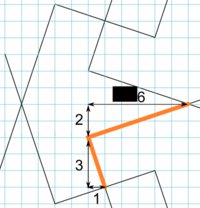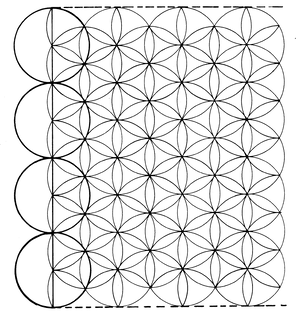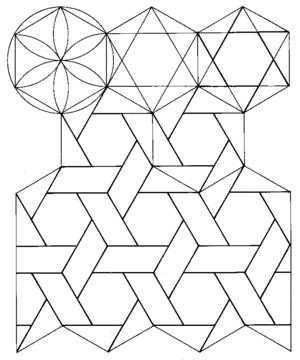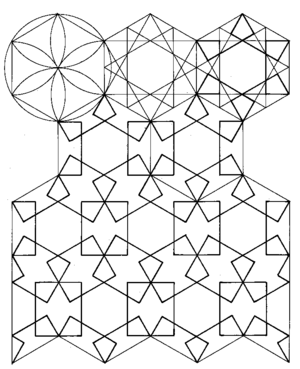Islamic Patterns Exploration
Objective: Create traditional Islamic wallpaper patterns.
Materials
Graph paper, ruler, compass.
Exploration
Islamic art has a strong tradition of using geometric patterns for decoration. This stems in part from the religious resistance to representing living beings [1] such as animal and human forms.
View some patterns
- Visit the Pattern in Islamic Art website for a major compendium of examples.
- Make your own patterns using the Taprats Java applet, at http://www.cgl.uwaterloo.ca/~csk/washington/tile/islam
Patterns with graph paper

- The Alhambra is a Moorish palace in Granada, Spain, known for its geometric decoration. The pattern shown at right is very common at the Alhambra, usually made with alternating black and white tiles. Construct this pattern.

The key point is that each 'arrow' shape in the pattern consists of sides with slope 3 or 1/3. That is, each side travels one graph paper square in one direction for every three in the other direction. Make the short sides travel 1 and 3 squares, and the long sides travel 2 and 6 sqaures. - Construct a Cairo pentagon tiling by following the Stick-Cross method at David Bailey's World of Escher-like Tessellations site.

Patterns with order 6 rotation
To create patterns with order 3 or order 6 rotational symmetry, you cannot use graph paper. Instead, these constructions begin by drawing a collection of circles, all the same radius.

- With a compass, draw a circle of a comfortable radius, maybe 1-2 inches.
- Pick a point on the first circle, and draw a second circle with the same radius.
- Your two circles intersect at two points. Draw new circles centered at each of those points.
- Continue to draw new circles, all the same radius, and all centered at intersection points of other circles, until the page is full.
- Connect the intersection points with straight lines to form a pattern of hexagons.
From here, you can add more lines to form six pointed stars, or traditional Islamic patterns such as these:[2]
Handin: One Alhambra arrow tessellation, one Cairo tessellation, and a hexagon pattern.
- ↑ Department of Islamic Art. "Figural Representation in Islamic Art". In Heilbrunn Timeline of Art History. New York: The Metropolitan Museum of Art, 2000–. http://www.metmuseum.org/toah/hd/figs/hd_figs.htm (October 2001)
- ↑ Geometric Concepts in Islamic Art, Issam El-Said and A. Parman, 1976



